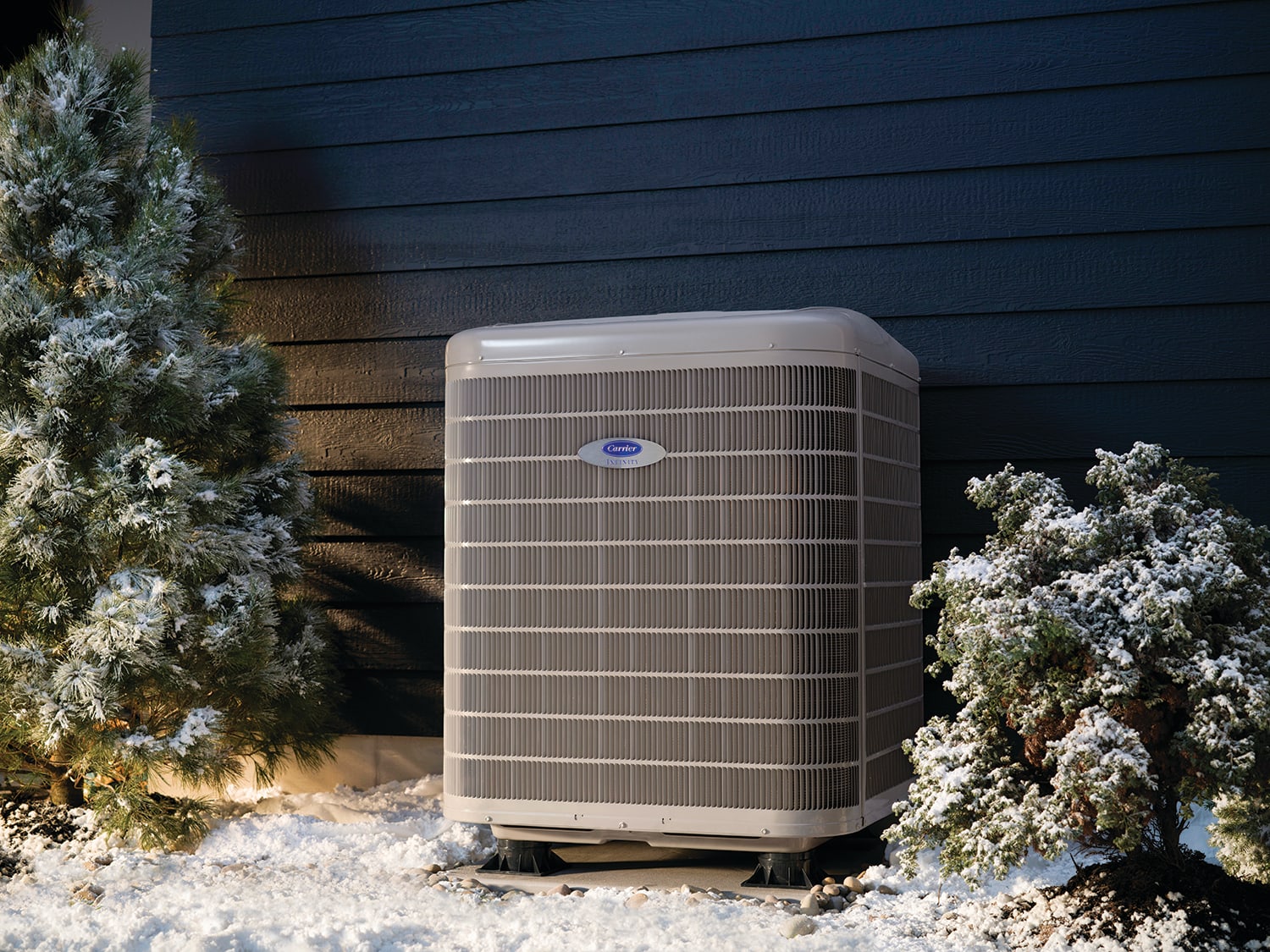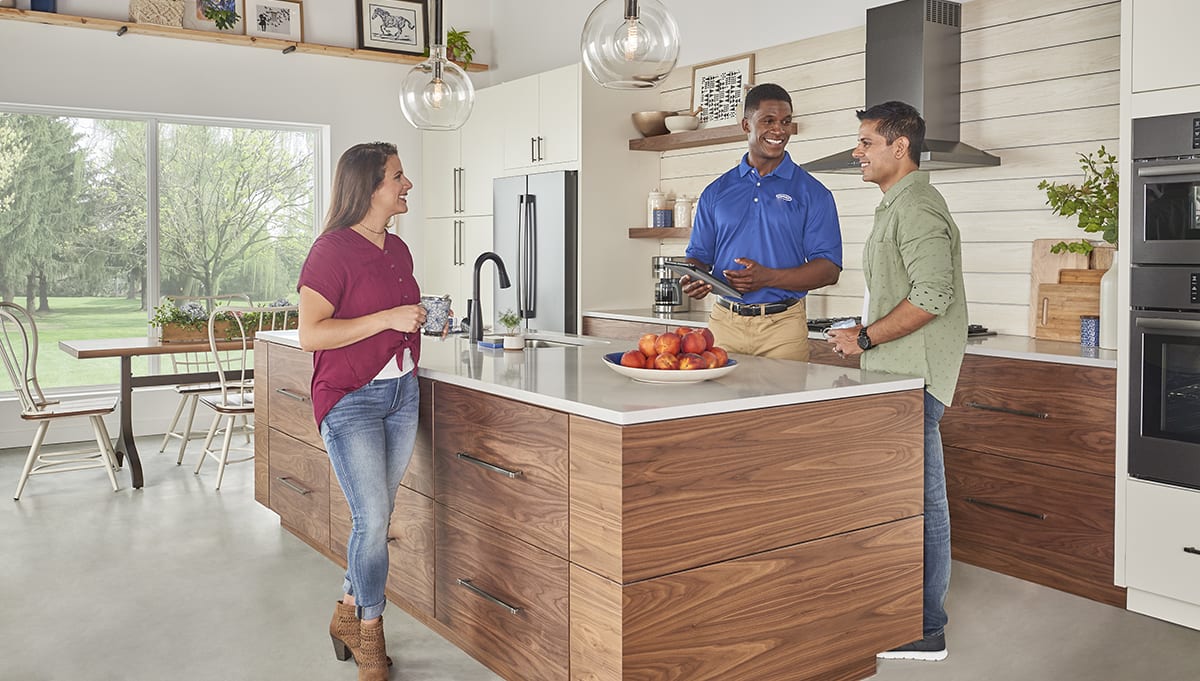HVAC Installation

New HVAC Installation: What to Consider
While centralized heating and cooling systems have been considered “standard” equipment in residential housing for many years, most average homeowners don’t have the expertise needed to select, size and install one for themselves.
That’s where we come in. Here is a summary of many of the factors involved with new AC installation:
Consult with a Local Expert On HVAC Installation
Doing your own research is helpful, but we always recommend contacting a trusted HVAC professional on HVAC installation for an expert assessment of your current system, your home, your heating and cooling system preferences, and your budget. A trained and licensed professional can provide insights into the types of systems that have worked well for others in the same area and with similar needs.
When it comes to HVAC installation, your local Carrier dealer is an expert in finding the right HVAC system for your needs and following up with professional delivery and setup to ensure optimal performance. (If you don’t already have one on speed dial, be sure to check out our website page to find a dealer near you.)
Get HVAC Installation Recommendations and an Estimate
Once your HVAC dealer has finished the assessment, you’ll get recommendations and an estimate for HVAC installation costs. This is where your research can come in handy. Be sure to follow up with questions about the equipment, including expected energy efficiency, sound levels, summertime humidity control, and if the system will qualify for rebates from your local utility (often tied to higher efficiency, ENERGY STAR® certified products). Review the cost estimates and ask for a breakdown if the quote isn’t clearly itemized. Your local Carrier comfort expert will have access to a wide range of air conditioner models to meet a wide range of needs.
How Long Does HVAC Installation Take?
Depending on the type of system, most typical central air conditioner installations can be completed by an experienced technician in four to eight hours. If your new model does not require any significant modifications to your current setup in terms of where it is installed, the size of the unit, refrigerant lines or electrical connections, the installation time should be closer to a four-hour time frame. For more complicated installations, or if you are also replacing your furnace at the same time, expect it to take longer.
Can I Perform An HVAC Installation Myself?
While it may be possible to locate and purchase a central air conditioning unit yourself, air conditioner installation is an entirely different issue. Unless you are a licensed HVAC technician with up-to-date training, installing a central air conditioning system yourself is not recommended for several reasons. It starts with proper sizing. For the best performance and comfort, selecting the right “sized” unit requires understanding how to calculate your home’s heating and cooling load requirements. An improperly sized system can potentially cost you money in the long run through poor efficiency, and it may not deliver the comfort it is designed to provide. Likewise, if the unit is not properly installed, it may not operate at full capacity and efficiency. Self-installation will likely void any type of warranty protection from the manufacturer. And, the refrigerants used in residential air conditioning are highly regulated. Your old refrigerant must be reclaimed and properly disposed of according to EPA regulations. Failure to do so is illegal and can result in significant fines.
Professional HVAC Installation
Professional installation of your new central air conditioner will be the best option for ensuring efficient, dependable comfort for years to come. A licensed HVAC technician will have the tools, the training and the experience needed to do the job according to local and national codes and requirements.
What is Included in a Professional HVAC Installation?
The short answer is everything! When you hire a trusted local HVAC technician, your professional HVAC installation will typically include
- The cost of the new air conditioner and delivery
- Labor costs for the crew
- Removal and disposal of the old unit
- Other materials required to complete the job. These may include a new evaporator coil, air handler, and a new composite or concrete pad to give the outdoor unit a solid and level base.
- New Carrier air conditioners also come “equipped” with a 10-year parts limited warranty* with timely registration.
* If properly registered within 90 days of original installation, otherwise 5 years (except in California and Quebec and other jurisdictions that prohibit warranty benefits conditioned on registration).
What is the Average HVAC Installation Cost?
The average Carrier air conditioner cost for installation can vary quite a bit. The size of your home, the climate in your area, the age and condition of your home and more can influence the installation and labor costs. The cost for the AC unit itself can vary as well depending on the size of the unit, its efficiency rating, number of cooling stages, and single or variable-speed operation. However, you might substantially lower your heating and cooling energy costs by replacing your system. In time, this could help make up for the costs of replacing the system.

Here are some average costs for installing AC systems:
Average Installed Cost for Central Air1
Additional labor fees specific to your home could increase these costs, plus ductwork modifications or new installation of ductwork could add up to $5,000 in additional cost.
| Average Installed Cost | Low End Cost | High End Cost |
| $5,850 | $2,900 | $9,000 |
Average AC Cost by Home/Unit Size1
| Home Size | Cooling Capacity (size) | Average Price Range |
| 750 – 900 square feet | 1.5 ton/18,000 BTUs | $2,500 - $4,500 |
| 1500 – 1800 square feet | 3 ton/36,000 BTUs | $3,400 - $5,400 |
| 2500 – 3000 square feet | 5 ton/60,000 BTUs | $4,300 – $6,800 |
Another factor to consider is the efficiency of the unit. Higher efficiency models will cost more up front but can provide long term savings on your energy bills for the life of the system. And, if you just need an upgrade due to a room addition or because one room in the home that just isn’t being cooled effectively, ductless mini splits are a solution many people are turning to. Ductless mini splits can target one room with up to 28.5 SEER2 energy efficiency. And, if the room isn’t being used, you can save even more by not turning on the ductless system at all.
AVERAGE SAVINGS FROM REPLACING YOUR HVAC SYSTEM
By installing a new HVAC system and integrating a smart thermostat, homeowners can see significant savings on their heating and cooling energy bills. For those replacing a heat pump or air conditioner that is more than 10 years old with a higher SEER2 model, they can save up to 20% on heating and cooling costs.2 Additionally, replacing a furnace or boiler that's over 15 years old can lead to a 15% reduction in heating energy costs.2
Get an Estimate for HVAC Installation
As you consider your options for your new HVAC installation, be sure to consider which HVAC company you want to work with. Carrier invented modern air conditioning and has been in the home comfort business since 1902. Today we continue developing new technologies and systems designed to improve comfort, performance and efficiency. Carrier has a nationwide network of HVAC contractors, so there should be a Carrier comfort expert available in your local market. To learn more about AC installation or our industry-leading air conditioners, be sure to find your local Carrier dealer.
Heating and Air Conditioning Units Carrier Dealers Install
Heating and Cooling
- Air conditioners
- Furnaces
- Heat pumps
- Ductless systems
- Evaporator coils
- Geothermal heat pumps
- Fan coils
- Boilers
- Packaged products
Indoor Air Quality

FREQUENTLY ASK QUESTIONS ABOUT HVAC INSTALLATION
While the entire HVAC installation process is fairly complex and requires a skilled, licensed technician, here are the main steps:
- Assessing and planning the installation.
- Removing the old HVAC system, if necessary.
- Installing the new HVAC system components, including the furnace, air conditioner, and ductwork if not already installed.
- Connecting the electrical and refrigerant lines.
- Testing the system to ensure it operates correctly.
- Providing a final walkthrough and instructions to the homeowner.
Choosing the right HVAC system involves evaluating several critical factors tailored to your unique needs. Start by considering your climate and regional conditions. For example, if you live in the hot, humid South, you’ll likely need a robust air conditioning system, whereas residents in colder Northern regions might prioritize efficient heating solutions. In many parts of the country, a combined heating and cooling system is the most practical option. Energy efficiency is a major consideration, especially if you’re looking to reduce your heating and cooling energy bills in a climate where the system will operate frequently. Look for high SEER2 ratings for air conditioners/heat pumps and high AFUE ratings for furnaces. Proper sizing is also crucial; undersized units will struggle to maintain comfort, while oversized units can lead to inefficient operation and higher costs. A local dealer can help with calculating furnace size, and answer question like "what size AC unit do I need?" or "what size of mini split do I need?"
Additionally, think about the specific features you need in an HVAC system. If humidity control is a concern, especially in regions with significant humidity fluctuations, a variable-speed system can be more effective in maintaining consistent temperatures and controlling moisture levels. This type of system adjusts the output to match the precise heating or cooling needs, providing enhanced comfort and efficiency. To ensure you choose the right HVAC system, it’s best to schedule an appointment with a local dealer. They can conduct a thorough assessment of your home, help you navigate options, and provide professional advice tailored to your specific requirements, ensuring you make an informed decision.
Learn More About HVAC Installation
- Learn about different HVAC system types
- Discover the furnace installation process
- Understand the steps of AC installation
- Learn about AC replacement
- What to consider when buying a furnace
- Have hot or cold spots in your home? Consider installing a ductless mini split
- Explore the value of inverter air conditioners
- Learn about HVAC financing and the benefits of HVAC financing

